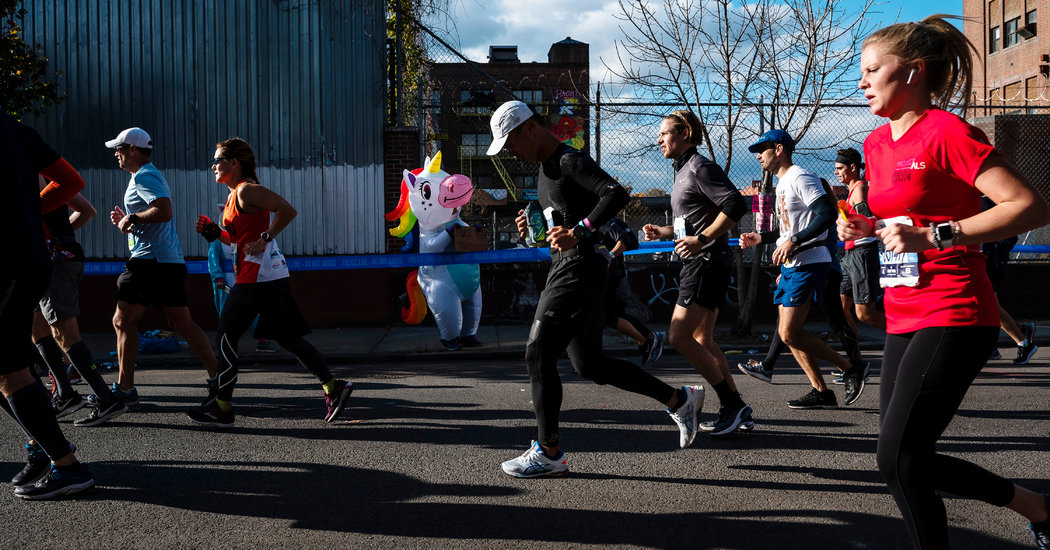
Could it be that marathon training and racing are actually good for our knees?
A myth-toppling new study of novice, middle-aged runners suggests that the answer is a qualified yes. The study finds that taking up distance running rebuilds the health of certain essential components of middle-aged knees, even if the joints start off somewhat tattered and worn.
But the results also contain a caution. Marathon mileage could erode one vulnerable area within the knee, the study finds, if runners are not careful.
Those of us who run can almost be assured of hearing from concerned friends and relatives that we are ruining our knees. This notion is so entrenched that it discourages some people from trying the sport and worries those of us who continue.
But little of the available research about knees in motion supports that idea. Most past experiments indicate that running generally is not harmful for healthy knees. In one much-cited study, elderly runners developed knee arthritis at lower rates than sedentary people. And in another, more recent study, young people’s knees grew less inflamed after a run than after a long stretch of sitting.
But most of this science has focused on whether running actively harms knees, not whether it might somehow refurbish and spiff up joints beginning to show signs of wear and tear.
That question became personal in 2012 for Dr. Alister Hart, an orthopedic surgeon and research professor at University College London and the Royal National Orthopaedic Hospital, who oversaw the new study. That year, he says, he ran his first marathon.
“For two weeks afterward, I needed a handrail to do stairs,” he says. “My quads were agony. My hip- and knee-replacement colleagues told me that I was mad.”
He, too, was a bit concerned on behalf of his knees, and decided that it would be a service to all runners to look closely at what marathon training might be doing to those joints. So, for the new study, which was published in October in BMJ Open Sport & Exercise Medicine (with funding primarily from voluntary contributions by Dr. Hart’s patients), he and his research associate Laura Maria Horga and other colleagues turned to the entry rolls of an upcoming London Marathon.
There, they identified and contacted middle-aged entrants who had listed themselves as first-time marathon runners. They wound up with more 80 novice racers, most in their mid-40s and few of whom had run or exercised much in the past.
The researchers asked these men and women about their knees. At this point, the marathon was still six months distant, and their joints were those of middle-aged adults and not yet those of runners. All of the soon-to-be marathoners responded that the joints were in good shape, with no creaks or pains.
The researchers then gathered the volunteers at a university facility and scanned everyone’s knees, using a sophisticated, high-resolution type of M.R.I. that reveals even minor damage in the joint’s tissues.
A few months later, the men and women began the same, four-month marathon-training program. Eventually, 71 of them finished the race, in an average time of 5 hours and 20 minutes. Two weeks later, they returned to the lab to have their knees re-scanned.
The scientists then compared their hundreds of before-and-after scans and turned up some surprises. For one, while the participants had reported at the start of the study that their knees felt fine, many, in fact, harbored damage. About half of the pre-training knees contained frayed or torn cartilage, and others showed lesions in the joint’s bone marrow. Similar patterns of tears and lesions can signal incipient bone erosion and arthritis, the researchers knew.
The post-race scans held other, new and unexpected results. “I expected to see additional damage” in runners’ knees, Dr. Hart said.
Instead, many of the existing bone-marrow lesions had shrunk, as had some of the damage in the runners’ cartilage. At the same time, some racers had developed new tears and strains in the cartilage and other tissues at the front of their knees, around the kneecap, a part of the joint known to be stressed during running. That area also, though, tends to be less prone to arthritis than other portions of the knee.
Over all, “the main weight-bearing knee compartments showed beneficial effects from the marathon,” says Dr. Horga, meaning that, in general, the knees were healthier.
Just how running remade the marathoners’ knees remains uncertain, she says, but it most likely involved strengthening of the muscles surrounding the joint, helping to stabilize it and reduce or even reverse tissue damage there. Meanwhile, the unfamiliar pounding of the running focused large forces on the kneecap area, overtaxing it.
Training on softer surfaces, such as trails or grass, might lessen the buffeting around the kneecap, she says, as could tinkering with shoes, mileage or running form, although any changes to training routines should be feathered in gradually.
Of course, this study was short-term and focused on middle-aged marathon newcomers with no history of knee problems. Whether running would be constructive for the knees of older runners or people whose joints ache is not certain. The scientists also do not know if changes in knee health linger or what the effects are on other joints, such as the hips. They are planning a six-month follow-up study of their participants’ knees, though, and a study of hips. The results will be posted at their website, runningforscience.org.

